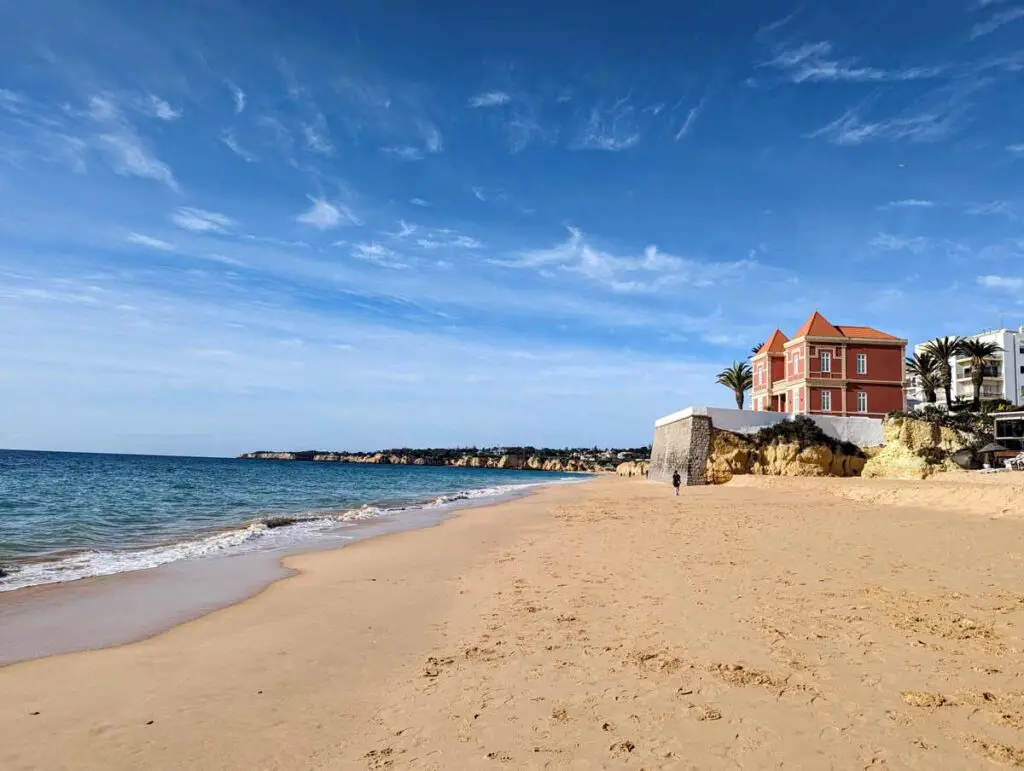Dreaming of a winter escape that won’t break the bank? One with beaches and pastéis de nata? If so, visiting the Algarve in winter might just be right for you.
While summer sees sees the Algarve sweltering under temperatures that can soar above 35°C (95°F), winter brings pleasant days hovering between 15-20°C (59-68°F) – perfect for exploring without the intense heat that can make peak season challenging, especially in accommodations without air conditioning.

What many visitors don’t realise is that winter transforms the Algarve into a different destination entirely. Gone are the long restaurant queues and packed beaches that characterise the summer months. Instead, you’ll find pristine stretches of golden sand perfect for peaceful walks, and you can often stroll right into the region’s best restaurants without a reservation.
My favourite bit? The prices! Accommodation prices often drop by 40-60%, flight costs plummet, and car rental rates can fall to as low as €15 per day – a fraction of summer prices.
What’s the Weather Like?

The Algarve’s winter temperatures hover around 18-20°C (64-68°F) during the day – comfortable enough for t-shirts, especially when hiking or being active. But I recommend you pack layers, as evenings can turn chilly enough to warrant a sweater, and many indoor spaces can feel cool since Portuguese buildings are designed to stay cool in summer rather than warm in winter.
Rain does make an appearance, but not in the persistent drizzle I’ve gotten used to in northern Europe. Instead, the Algarve typically experiences concentrated periods of heavy rainfall lasting a few weeks, which could fall either before or after Christmas – there’s no reliable pattern. Once these rainy spells pass, you can expect the region to brighten up again with clear, sunny skies. Just what the doctor ordered!
Location matters too. The western Algarve tends to be a couple of degrees cooler and windier than central or eastern areas, and coastal areas generally feel fresher than inland spots. Again, pack accordingly.
Where to Stay

Deciding where to stay comes down to your preferred travel style and what you’re looking to experience.
Personally, I suggest renting a car in the Algarve even if it’s just for a few days, but it’s not essential. While having a car gives you ultimate flexibility, the region is still accessible by public transport – you just need to plan carefully as the availability of public transport varies.
The main transport hubs are Faro and Portimão, offering both bus and train connections throughout the region. The train line runs through major stops including Vila Real de Santo António, Tavira, Olhão, Faro, Albufeira, Tunes, Silves, Portimão, and Lagos. However, be aware that some train stations, like Albufeira’s (6km) and Silves’ (2km), sit well outside their town centers.
Another major consideration: beach access (after all, that’s half the reason you’re here, right?). Eastern towns like Faro and Tavira require ferry rides to reach their beaches, while inland locations like Tunes and Silves are obviously inland and so you’ll need some form of transport to get to the beach.
Still not sure where to go? Some of the most popular locations in the Algarve include Faro, Tavira, Silves, Portimão, and Lagos.
Faro

Faro, the regional capital, offers the most historical attractions including the fascinating Capela dos Ossos (Bone Chapel), decorated with human bones and skulls from over 1,000 monks. The city center features well-preserved fishermen’s houses and excellent transport connections to Spain and the rest of Portugal. Note that beaches require a ferry ride and aren’t walkable from the city centre.
Tavira
Tavira mixes its traditional charm with an absence of high-rises and plenty of historic architecture. Popular among retirees, it offers quality restaurants and a quieter atmosphere. Like Faro, beaches are accessible by ferry rather than on foot. It’s peaceful and charming. What more could you ask for?
Silves
Silves, crowned by its impressive medieval castle, stays lively even in winter. This inland town provides a more authentic Portuguese experience with its historic center and cathedral.
This is one of the most popular inland towns for prospect expats to move to, so if you’re considering making the Algarve your home, it’s worth spending some time here.
Portimão
Portimão, the region’s second city, is rapidly developing. While less picturesque than other towns, it offers vibrant city life with plenty of restaurants and a growing expat community. The stunning Praia da Rocha beach is within walking distance (2km) and particularly peaceful in winter.
Lagos
Lagos attracts a diverse crowd, especially digital nomads and surfers. It combines walkable beaches, good public transport, and a mix of traditional Portuguese and international dining options. The town maintains a low-rise character while offering enough amenities to support its international community.
Personally, I think this offers a good balance of everything (great public transport and accessible beaches) but note that the cost of accommodation is typically higher here.
What to Do In the Algarve in Winter
Looking for something to do besides working on that all-important tan? Here are some of my top suggestions.
Boat Trips

There’s something magical about avoiding the summer crowds. Those stunning Benagil caves that usually require queueing for hours? In winter, you can often have them almost to yourself. I’ll never forget gliding through on a small boat tour, the winter light creating perfect photo conditions as it filtered through the cave openings.
Don’t miss taking a boat through the Ria Formosa. On a calm winter day, you can spot dolphins playing in the clearer waters, then stop for lunch at Restaurante Estaminé on Ilha Deserta. There’s nothing quite like fresh seafood on a ‘deserted island’ while watching winter waves roll in.
Sight-Seeing

The mild temperatures make this the ideal time to explore historic towns that can be stifling in summer. Walking the ramparts of Silves Castle or wandering through Tavira’s cobbled streets is so much more enjoyable when you’re not battling 35-degree heat.
Each town tells its own story – from the haunting Bone Chapel in Faro to the Moorish influences in Castro Marim’s fortress.
Walking
For outdoor enthusiasts, the Seven Hanging Valleys trail offers some of Europe’s most spectacular coastal walks. The winter air is crisp and clear, perfect for photographing those dramatic limestone cliffs. More ambitious? The multi-day Fisherman’s Trail lets you experience the wild western coast at its most atmospheric while the Algarve Way is perfect for exploring the interior.
Learn to Surf
Speaking of the west coast – winter is when serious surfers come alive. Sure, you’ll need a wetsuit, but there’s something exhilarating about catching your first wave with just a few other learners around. As the surf schools are less crowded, you’ll get more personalized attention as you master the basics.
Beach
Finally, just head to the beach. There’s something special about being able to catch a few rays of sunshine in December or January while the rest of the world is tucked away inside, trying to keep warm. And you’ll have no shortage of beaches to choose from – there are around 100 beaches on the Algarve.
Many of these beaches – like Praia da Marinha – can be incredibly busy during summer and often you can’t even get onto them. In winter, that’s much less of a problem.
What to Eat
The Algarve’s cuisine might be overshadowed by Portugal’s northern regions, but it offers some remarkable dishes that showcase both its coastal location and inland traditions.
Cataplana
While here, you’ll want to try the region’s most iconic creation: cataplana. Named after the distinctive copper pot it’s cooked in, this seafood stew seals in rich flavors that have been perfected since Moorish times. Every restaurant prepares it differently, but expect a fragrant mix of fresh fish, shellfish, or sometimes pork with clams.
Piri-Piri Chicken

You can’t miss trying piri-piri chicken, particularly in Guia near Albufeira – the town considered its spiritual home. The local churrasqueiras (grill houses) serve up perfectly spiced chicken that’s worlds apart from the Nando’s chain version you might be familiar with.
Sweets
Save room for dessert – the Algarve’s sweet treats are distinctive and delightful. Look for doces finos, intricate marzipan sweets shaped like fruits and animals, or try Dom Rodrigos from Tavira, made with egg threads, almonds, and cinnamon. Queijo de Figo, a ‘cheese’ made from figs and almonds, makes for a perfect gift to take home.
Of course, you should try a pastel de nata (custard tart) too! While not from the Algarve originally, you’ll find them for sale in just about every cafe on the Algarve.
Medronho
End your meal like a local with a shot of medronho, a potent spirit made from the fruit of the strawberry tree. It’s particularly associated with Monchique, and while you’ll find it in supermarkets, the best versions are often local productions shared over post-dinner conversations.
Thinking of Moving Here?
Winter in the Algarve offers an ideal opportunity for a “scouting trip” if you’re considering a move to Portugal. With lower rental costs and fewer tourists, you’ll experience authentic daily life while completing essential groundwork for residency – although, being honest, the crowded summer months are just as much an “authentic” part of what living on the Algarve is really like.
Portugal’s visa options include the D7 for retirees and passive income earners, and the Digital Nomad visa for remote workers. Though you’ll need to return home to submit your application, use your time here to open a Portuguese bank account and scout long-term rentals.
For banking, you’ll need a NIF number, obtainable through online services or in person with a fiscal representative. Writing on Portugalist, James Cave suggests that while some banks may initially decline you for being a non-resident due to money laundering regulations, persistence often pays off, and you will eventually find a bank that’ll open an account if you keep trying.
Handling this yourself can save hundreds compared to using relocation services or a lawyer. Popular banks for expats include Novobanco and Millennium BCP. James Cave also provides guidance on getting a NIF number as a non-resident both on Portugalist and in his book, Moving to Portugal Made Simple.
Finding long-term accommodation can be challenging, as many landlords prefer seasonal tourism rentals. However, securing a 12-month rental contract is typically required for visa applications, and conducting your search in person during winter gives you a significant advantage over trying to arrange this from abroad.
Challenges

Unfortunately, it’s not all sunshine and rainbows. Winter in the Algarve brings two main challenges: cold homes and quiet towns.
Portuguese houses are built to stay cool in summer, which is a drawback in winter. Most lack central heating and proper insulation, making them difficult and expensive to heat. Electric heaters are available but costly to run – some Airbnb hosts even charge extra for their use. The heat quickly dissipates through poorly insulated walls and windows, meaning heaters need to run continuously to maintain warmth.
This isn’t a major concern if you’re out exploring, but it can be uncomfortable for remote workers spending long hours indoors. To minimize the impact, look for properties that catch natural sunlight, particularly in countryside locations. Town properties overshadowed by other buildings can be notably colder. If you’re working from home, or just watching TV on the couch, I’ve found electric blankets to be a very cost-effective way of staying warm without inflating your heating bill.
The seasonal nature of tourism also affects the atmosphere. From November to March, many coastal towns become notably quiet as businesses close for maintenance and staff take well-earned breaks after the intense tourist season (April to October).
Restaurants, cafes, and shops often shut completely, creating a ghost town feel in more tourist-focused areas. Personally, I like it, but it can feel too subdued for others expecting more vibrant destinations.
There is a third thing to consider: Christmas. Here’s the thing: we all like to celebrate Christmas in a way that’s familiar to us. If you’re from a Northern European country, you may be used to dark days, cold weather, and Christmas markets. Well, you’re not going to get that in the Algarve. That’s obviously a pro from many points of view, but the region does lack a bit of a Christmas-y feeling.
That said, if the idea of having Christmas dinner on your terrace in the sunshine appeals, this could be the perfect place for you.
Conclusion

With mild temperatures, empty beaches, and significantly lower prices, you’ll experience a different side of Portugal’s southern coast. While cold homes and quieter towns might take some adjustment, the benefits often outweigh these minor inconveniences.
You might not get the traditional Christmas markets or snowy scenes of northern Europe, but there’s something magical about enjoying Christmas dinner on a sun-drenched terrace or walking along an empty beach on New Year’s Day. For those willing to trade traditional winter landscapes for mild temperatures and gentler prices, the Algarve in winter might just be your perfect destination.
Just remember to pack layers, choose your base carefully, and embrace the peaceful atmosphere that makes this season special.
Like it? Pin it!

Disclaimer: Some of the links on this website are “affiliate links.” This means that if you click on the link and do a purchase, I will receive an affiliate commission at no extra cost for you. This helps me keep my website running and continue to share my travelling knowledge with you. I thank you for booking your flights or hotels using the links on my website. Regardless, I only recommend products or services I use personally and believe will add value to my readers.





I absolutely love that you can still rent a boat in some parts. I feel like it can be so rare in certain consistently warmers areas like this. Lovely piece.
I’ve always wanted to visit the Algarve! You’ve given me some great inspiration to plan a winter trip!
love your blog name from a fellow women travel blogger!
Really great article! Thorough and informative, and very helpful for planning a trip to this fascinating area of the world.
I may just have to add this to my next winter destination. This would be another side of Portugal I haven’t seen. I really appreciate all the info!
Thank you for such a thorough itinerary. This is excellent information.